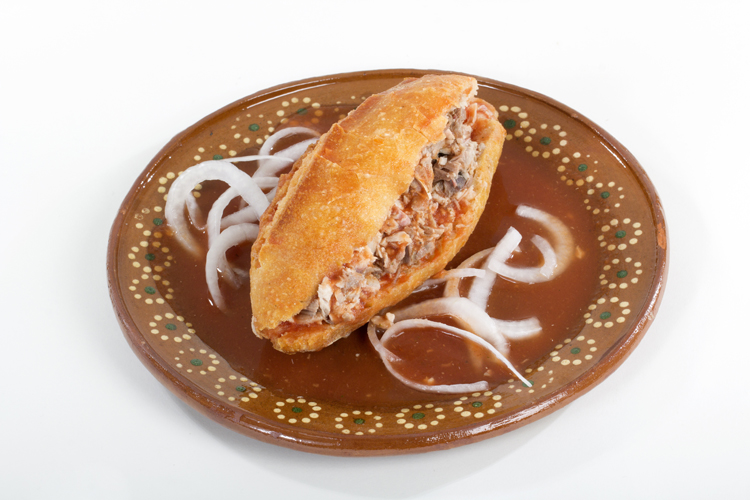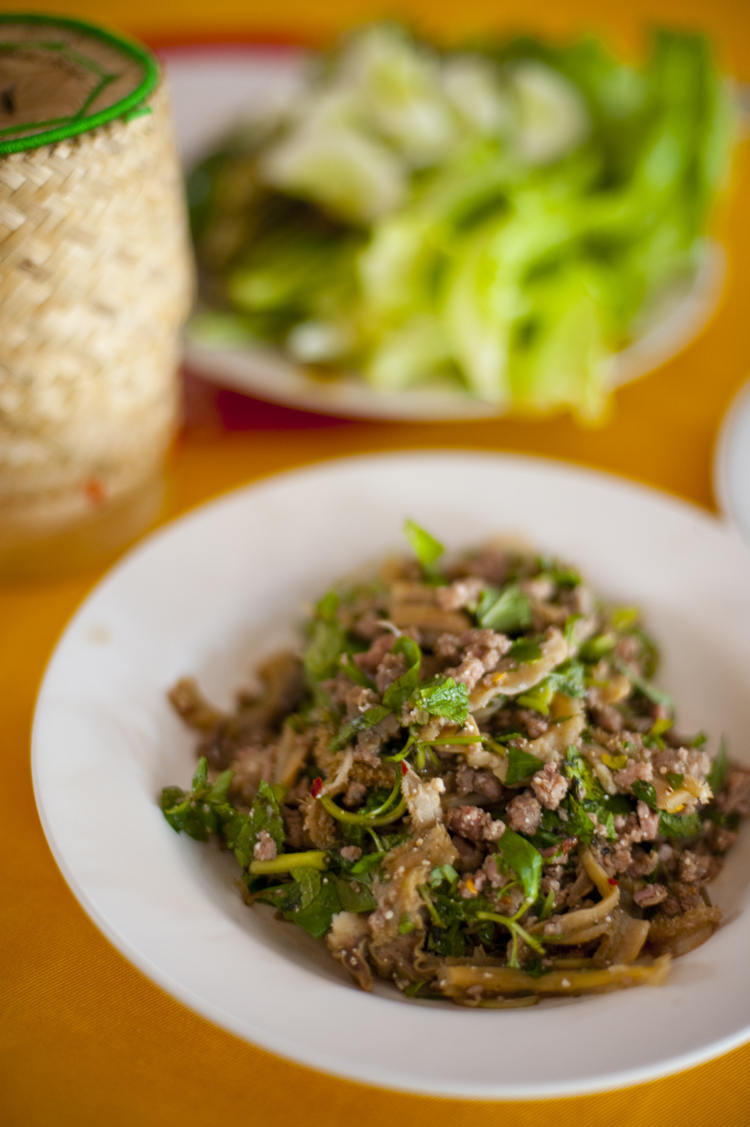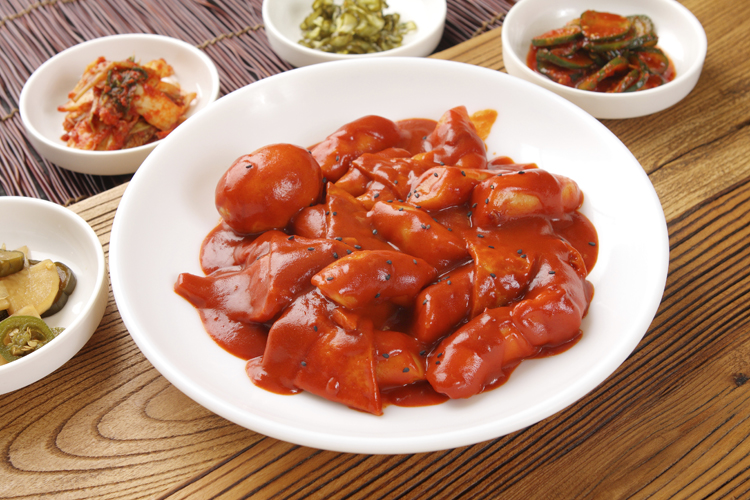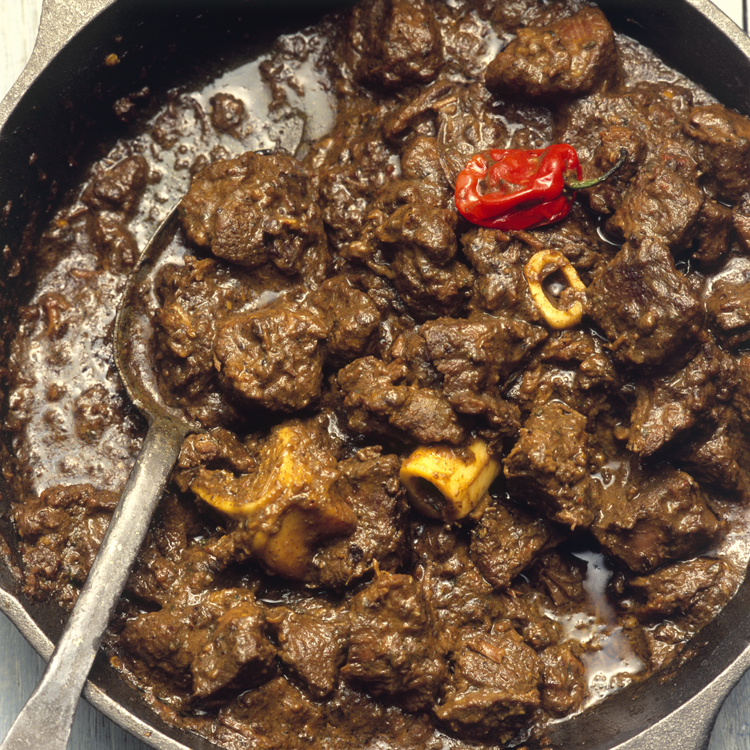
Can you handle the heat of a torta ahogada? Image by Arturo Peña Romano Medina / E+ / Getty Images.
In the Mexican city of Guadalajara, the torta ahogada – literally 'drowned sandwich' – is considered a cure for everything from hangovers to heartbreak. A heap of roast pork with pickled onions on a local birote roll, the torta can be ordered media ahogada (half dipped in flaming red chile de arbol sauce) or, for a thorough tongue blistering, bien ahogada (totally submerged). Pick it up and let the crimson juices run down your arms as you stand at the street vendor’s high metal counter. Or use a fork. We won’t tell.
The most classic way to try a torta ahogada is during a soccer match at Guadalajara’s Estadio Jalisco, where vendors sell them in plastic bags for around 30 pesos.

A mouth watering (and mouth tingling) plate of beef laap. Image by Austin Bush / Lonely Planet Images / Getty Images.
A staple dish in Laos and in the adjacent Isan region of Thailand, laap (often spelled ‘larb’ on Thai menus) is a ground meat salad laced with lime juice and fish sauce, and tossed with fragrant toasted ground rice and numbingly spicy bird chilis – lots and lots of chilis. Typically eaten with Laotian-style sticky rice, it’s a mouth-tingling lunch or dinner. For contrast (and tongue-cooling), laap usually comes with an array of refreshing vegetables, from tiny striped eggplants to cucumbers to springs of mint.
Sample Laotian laap in the magical mountain city of Luang Prabang, where restaurant and cooking school Tamarind includes laap on several of their regional tasting menus (from 100,000 kip).
When it comes to sizzling Chinese cuisine, most of us think ‘Sichuan’. But it’s actually the food of the adjacent province of Hunan that takes top prize for spiciness. Steamed fish heads in chili sauce (duòjiāo zhēng yú tóu), a signature Hunanese dish, features two handfuls of atomic Hunan chilies – one red, one green. While Sichuan cuisine relies on the 'mala' or 'numbing spiciness' of Sichuan peppercorns, the heat in these steamed fish heads is all the classic, capsaicin-based kind.
Try steamed fish heads in chili sauce at Huo Gong Dian, or 'Fiery Palace', an ancient restaurant (established 1747) in the Hunan city of Changsha.
Downing this British Indian dish is a common challenge among drunken university students in the UK, where phaal was allegedly invented to satisfy daredevils’ requests for 'your hottest curry'. Unknown in India (where the citizens sensibly prefer their food edible), phaal’s heat comes from the bhut jolokia, or 'ghost pepper', an Indian chili consistently rated as one of the world’s hottest.
Though phaal is British, the most notorious place to try it is in New York, at the British-Indian-style Brick Lane Curry House . After agreeing to a (verbal) disclaimer, anyone who can finish their 'excruciatingly' hot phaal earns a spot in their 'P'hall of Fame.'

The redder the better when it comes to tteokbokki. Image by whitewish / E+ / Getty Images.
The foundation of this popular Korean street snack is soft boiled rice cake doused with chili sauce. Toppings and seasonings range from onion to shrimp to fish cake to eggs to sesame seeds, depending on the vendor – any Seoul-dweller worth their salt has their favorite style. Not all tteokbokki are spicy – remember, the redder the sauce, the spicier the snack.
Look for tteokbokki at Seoul’s busy Gwangjang Market, with some 200 food stalls selling all of Korea’s favorite nibbles (dishes cost about 4000-10,000 won).

Bring on the hottest of the hot peppers in curry goat. Image by Hugh Johnson/Dorling Kindersley/Getty Images.
It wouldn’t be a party in Jamaica without a bubbling cauldron of curry goat, a flaming-hot goat meat stew. The heat comes from the Scotch bonnet, a Caribbean pepper variety that rates between 100,000 and 350,000 on the Scoville Scale, which scientists use to measure pepper heat – a jalapeno, by contrast, rates between 2500 and 8000. Some cooks cool down their curry goat with potatoes or coconut milk, and there’s always rice to soothe your throbbing tongue.
While the best place to try curry goat is at a local backyard party, if you can’t get an invite, try the famous curry goat at Moby Dick restaurant in downtown Kingston.
Cultivated in and around the city of St Augustine in Northern Florida – America’s oldest European settlement – these chilies’ small size belies their enormous punch. Locals claim the peppers were brought to Florida by workers from the Spanish island of Minorca in the 1700s, though historians (always ruining a good story!) suggest they more likely hailed from South America. Either way, they create a blistering, smoky-sweet sauce that’s hard to find outside of St Augustine.
Sample the finest datil pepper sauce at the Pepper Palace near St Augustine’s Old City gates. This emporium of all things spicy has dozens of varieties of datil sauces and chutneys, even datil-spiced mustard. For more immediate satiation of your chili needs, head to St Augustine’s The Hyppo , a gourmet popsicle shop whose ever-changing menu of flavors includes a variety of datil-spiked fruit combos (pops $3.50).
Pick up a copy of The World's Best Spicy Food for a culinary tour of the hottest dishes on earth, including where to find them while travelling and how to make them at home. Published by Lonely Planet in March 2014.